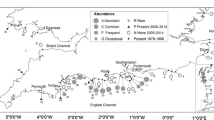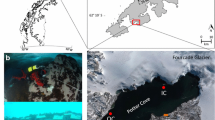Abstract
Demographic and phenological attributes that characterize rare and scarce species have not been extensively investigated for marine benthic organisms. From 1984 to 1987, 1 investigated the population ecology of the low intertidal, psammophytic green algaCodium setchellii Gardner that forms low-density populations on sand-influenced rocky benches on N.E. Pacific shores. To address why the alga is not more common in the habitat in which it is most abundant, I quantified sand fluctuations and population dynamics ofC. setchellii at several sites along the central coast of Oregon, USA. Sand movement was highly unpredictable both spatially and temporally on a local scale. AlthoughC. setchellii became fertile in late autumn to winter, the alga and rocky surfaces were often deeply buried by sand in these seasons. Algal recruitment was also spatially and temporally variable, and mortality of small thalli was high. Thallus growth was generally slow, and the alga had the capacity to persist at a given size for long periods. On sand-influenced rocky shores, mortality of largethalli was low, with some thalli persisting for several years. In laboratory experiments,C. setchellii lost substantial biomass during 4 to 5 wk sand burials, whereas two sympatric species of psammophytic algae lost little to no biomass. The within-site scarcity ofC. setchellii may be a consequence of (1) largely unpredictable environmental conditions that reduce algal recruitment and survival, and (2) apparent lack of specialized anatomical or reproductive adaptations to persist on sand-scoured rocky shores. The alga's persistence may be due to its slow growth and long lifespan.
Similar content being viewed by others
References
Abbott IA, Hollenberg GJ (1976) Marine algae of California. Stanford University Press, Stanford
Airoldi L, Rindi F, Cinelli F (1995) Structure, seasonal dynamics and reproductive phenology of a filamentous turf assemblage on a sediment influenced, rocky subtidal shore. Botanica mar 38: 227–237
Bold HC, Wynne MJ (1978) Introduction to the algae: structure and reproduction. Prentice-Hall, Inc, Englewood Cliffs, New Jersey
Burrows EM (1991) Seaweeds of the British Isles. Vol.2. Chlorophyta. Natural History Museum Publications, London
Churchill AC, Moeller HW (1972) Seasonal patterns of reproduction in New York populations ofCodium fragile (Sur.) Hariot subsp.tomentosoides (Van Goor) Silva. J Physiol 8: 147–152
Clemens KE, Komar PD (1988) Oregon beach-sand compositions produced by the mixing of sediments under a transgressing sea. J sedim Petrol 58: 519–529
Dahl AL (1969) The effect of environment on growth and development ofZonaria farlowii. Proc int Seaweed Symp 6: 123–132 [Margalef R (ed) Imprenta Juvenil Barcelona, Santiago de Compostela]
Dahl AL (1971) Development, form and environment in the brown algaZonaria farlowii (Dictyotales). Botanica mar 14: 76–112
Daly MA, Mathieson AC (1977) The effects of sand movement on intertidal Seaweeds and selected invertebrates at Bound Rock, New Hampshire, USA. Mar Biol 43: 45–55
D'Antonio CM (1986) Role of sand in the domination of hard substrata by the intertidal algaRhodomela larix. Mar Ecol Prog Ser 27: 263–275
Dellow V (1953) The genusCodium in New Zealand. Part II. Ecology, geographic distribution. Trans R Soc NZ 80: 237–243
Devinny JS, Volse LA (1978) Effects of sediments on the development ofMacrocystis pyrifera gametophytes. Mar Biol 48: 343–348
Drury WH (1974) Rare species. Biol Conserv 6: 162–169
Fletcher RL, Blunden G, Smith BE, Rogers DJ, Fish BC (1989) Occurrence of a fouling, juvenile, stage ofCodium fragile ssp.tomentosoides (Goor) Silva (Chlorophyceae, Codiales). J appl Physol 1: 227–237
Gardner NL (1919) New Pacifie coast marine algae, IV. Univ Calif Publs Bot 6: 487–496
Hawkes MW (1992) Conservation status of marine plants and invertebrates in British Columbia: are our marine parks and reserves adequate? In: Rautio S (ed) Community action for endangered species. Federation of B.C. Naturalists and N.W. Wildlife Preservation Society, Vancouver, pp 87–101
Kattan GH (1992) Rarity and vulnerability: the birds of the Cordillera Central of Colombia. Conserv Biol 6: 64–70
Komar PD (1976) Beach processes and sedimentation.Prentice-Hall, Inc, Englewood Cliffs, New Jersey
Littler MM, Littler DS, Lapointe BE (1988) A comparison of nutrient- and light-limited photosynthesis in psammophytic versus epilithic forms ofHalimeda (Caulerpales, Halimedaceae) from the Bahamas. Coral Reefs 6: 219–225
Littler MM, Martz DR, Littler DS (1983) Effects of recurrent sand deposition on rocky intertidal organisms: importance of substrate heterogeneity in a fluctuating environment. Mar Ecol Prog Ser 11: 129–139
Markham JW (1968) Studies on the haptera ofLaminaria sinclairii (Harvey) Farlow, Anderson et Eaton. Syesis 1: 125–131
Markham JW (1972) Distribution and taxonomy ofLaminaria sinclairii andL. longipes (Phaeophyceac, Laminariales). Phycologia 11: 147–157
Markham JW (1973) Observations on the ecology ofLaminaria sinclairii on three northern Oregon beaches. J Phycol 9: 336–341
Markham JW, Newroth PR (1972) Observations on the ecology ofGymnogongrus linearis and related species. Proc int Seaweed Symp 7: 127–130 [Nisizawa K (ed. in chief) University of Tokyo Press, Tokyo]
Mathieson AC (1967) Morphology and life history ofPhaeostrophion irregulare S. et G. Nova Hedwigia 13: 293–318
Newroth PR, Markham JW (1972) Observations on the distribution, morphology, and life histories of some Phyllophoraceae. Proc int Seaweed Symp 7: 120–126 [Nisizawa K (ed. in chief) University of Tokyo Press, Tokyo]
Pagel MD, May RM, Collie AR (1991) Ecological aspects of the geographical distribution and diversity of mammalian species. Am Nat 137: 791–815
Phinney HK (1977) The macrophytic marine algae of Oregon. In: Krauss RW (ed) The marine plant biomass of the Pacifie Northwest toast. Oregon State University Press, Corvallis, Oregon pp 93–116
Quinn, JF (1982) Competitive hierarchies in marine benthic communities. Oecologia 54: 129–135
Rabinowitz D (1981) Seven forms of rarity. In: Synge H (ed) The biological aspects of rare plant conservation. John Wiley & Sons, Ltd, Chichester, pp 205–217
Rabinowitz D, Cairns S, Dillon T (1986) Seven forms of rarity and their frequency in the Hora of the British Isles. In: Soule ME (ed) Conservation biology: the science of scarcity and diversity. Sinauer Associates, Inc., Sunderland, Mass., pp 182–204
Ramus J (1972) Differentiation of the green algaCodium fragile. Am J Bot 59: 478–482
Saetersdal M (1994) Rarity and species/area relationships of vascular plants in deciduous woods, western Norway — applications to nature reserve selection. Ecography 17: 23–38
Santelices B, Montalva S, Oliger P (1981) Competitive algal community organization in exposed intertidal habitats from Central Chile. Mar Ecol Prog Ser 6: 267–276
Silva PC (1951) The genusCodium in California with observations on the structure of the walls of the utricles. Univ Calif Publs Bot 25: 79–114
Silva PC (1992) Geographit patterns of diversity in benthic marine algae. Pacif Sci 46: 429–1137
Smith GM (1969) Marine algae of the Monterey Peninsula, California. 2nd edn. Stanford University Press, Stanford
Stewart JG (1983) Fluctuations in the quantity of sediments trapped among algal thalli on intertidal rock platforms in southern California. J exp mar Biol Ecol 73: 205–211
Thomas CD, Mallorie HC (1985) Rarity, species richness and conservation: butterflies of the Atlas mountains in Morocco. Biol Conserv 33: 95–117
Trowbridge CD (1992) Mesoherbivory: the ascoglossan sea slug Placida dendritica may contribute to the restricted distribution of its algal host. Mar Ecol Prog Ser 83: 207–220
Trowbridge CD (1995) New Zealand opisthobranchs associated with the low intertidal, crustose green alga Codium convolutum: Ascoglossans “Down Under”. Veliger 38: 116–125
Whittaker RH (1960) Vegetation of the Siskiyou mountains, Oregon and California. Ecol Monogr 30: 279–338
Author information
Authors and Affiliations
Additional information
Communicated by M.F. Strathmann, Friday Harbor
Rights and permissions
About this article
Cite this article
Trowbridge, C.D. Demography and phenology of the intertidal green algaCodium setchellii: The enigma of local scarcity on sand-influenced rocky shores. Mar. Biol. 127, 341–351 (1996). https://doi.org/10.1007/BF00942119
Received:
Accepted:
Issue Date:
DOI: https://doi.org/10.1007/BF00942119




